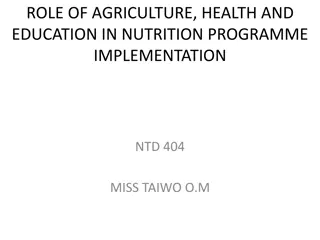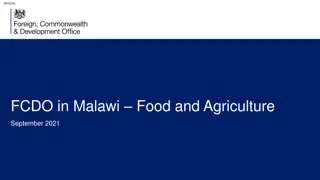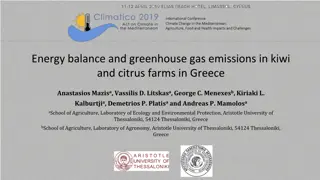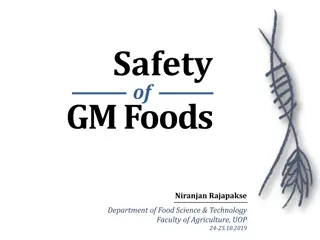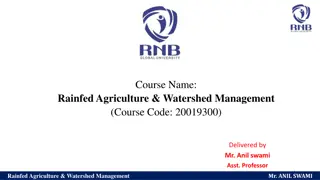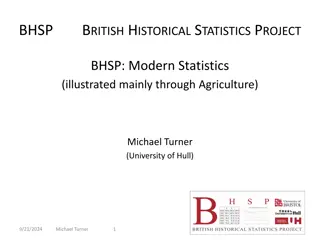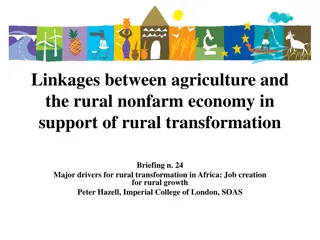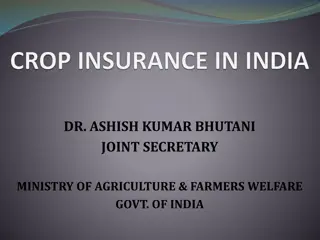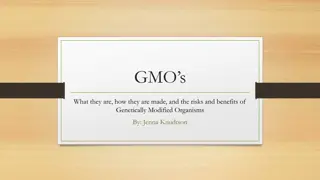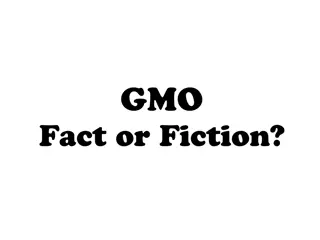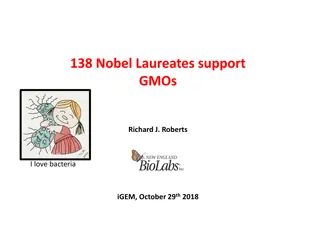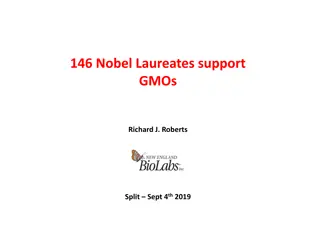The Impact of GMOs on Agriculture and Society
Genetically Modified Organisms (GMOs) are created through genetic engineering techniques like biolistics and Agrobacterium tumefaciens. These modifications are made to confer herbicide resistance, pathogen resistance, control fruit ripening/rotting, and increase production. The documentary explores the reasons behind making GMOs, including agricultural, health, and environmental benefits. It also discusses the effects of conventional breeding on crops and the implications of GMOs on our food system.
Download Presentation

Please find below an Image/Link to download the presentation.
The content on the website is provided AS IS for your information and personal use only. It may not be sold, licensed, or shared on other websites without obtaining consent from the author. Download presentation by click this link. If you encounter any issues during the download, it is possible that the publisher has removed the file from their server.
E N D
Presentation Transcript
Extra Credit Opportunity View the documentary The Future of Food. It is available online via Blackboard, as a DVD from the Media Library, and probably also through Netflix, etc. Write a one-page response and cut-and-paste into Blackboard as a journal entry (instructions on BB). Due Sunday, April 3 at midnight. Please consult Blackboard for full instructions.
What are GMOs? Genetically Modified Organisms Conventional breeding Genetic Engineering
What are GMOs? Genetically Modified Organisms Conventional breeding Genetic Engineering
Conventional Breeding Selecting individuals for breeding that have desired traits. wolf Genes inherited from a parent
Effects of conventional breeding on familiar crops cultivated tomato wild tomato Wild teosinte Modern corn Teosinte/corn hybrid Prakash, 2001
How do you make a GMO? or How does Genetic Engineering work?
How do you make a GMO? 1. Biolistics Genes added using technology 2. Agrobacterium tumefaciens Shirley Owens
Why do people make GMOs? 1. Agricultural reasons 2. Health reasons 3. Environmental reasons
Why do people make GMOs? 1. Agricultural Reasons Confer herbicide resistance Confer pathogen resistance Control fruit ripening/rotting Increase production
Why do people make GMOs? 1. Agricultural Reasons Confer herbicide resistance Confer pathogen resistance Control fruit ripening/rotting Increase production
Herbicide resistance Plants engineered to be resistant to the common herbicide, RoundUp. RoundUp Ready soybeans
How RoundUp resistance works: RoundUp inactivates an essential enzyme - EPSP synthase
How RoundUp resistance works: RoundUp inactivates an essential enzyme - EPSP synthase The plant DIES
How RoundUp resistance works: In RoundUp Resistant plants EPSP synthase no longer binds RoundUp. Gly96-> Ala 1 amino acid is changed in this enzyme to make it resistant. The plant LIVES The other 443 amino acids remain the same.
Why do people make GMOs? 1. Agricultural Reasons Confer herbicide resistance Confer pathogen resistance Control fruit ripening/rotting Increase production
Papaya Pathogen Papaya ringspot virus (PRSV) Interferes with the plant s ability to photosynthesize Transmitted by aphids Symptoms Most plants fail to flower Plants die young Fruits are marred with green spots
History of PRSV in Hawaii First reported in Hawaii in the 1940 s Wiped out papaya production in Oahu in the 1950 s and 1960 s. Commercial Papaya production moved to the Puna district on Hawaii Island By 1994, PRSV was wide-spread in Puna By 1997, commercial papaya production was cut by 50% due to losses from PRSV Puna
Goal: develop a PRSV-resistant papaya No naturally resistant cultivars Previous finding: tobacco plants that make a protein from the virus were resistant to the virus Tried the same approach with PRSV - it worked!
Field trials of the transgenic papaya Started in 1992, just months before PRSV swept through Puna The transgenic lines were made from cultivars already popular with Puna farmers (Sunset, Kapaho) Rainbow (transgenic) Non-transgenic Rainbow (transgenic) Non-transgenic
Papayas in Hawaii today The researchers gave seeds of the transgenic plants, Rainbow , to growers for free. (1998). http://www.nass.usda.gov/hi http://www.apsnet.org/ONLINE/FEATURE/RINGSPOT/ http://www.agbioforum.org/v7n12/v7n12a07-gonsalves.htm
In the past few years, cultivation of non- GMO papaya plants in Hawaii has increased. How do they avoid the virus? 1. Farmers spray the fields to prevent virus infection. 2. Big fields of resistant papayas (GMO papayas) block the spread of the virus to neighboring organic farms. 3. The virus has largely disappeared.
Why do people make GMOs? 1. Agricultural Reasons Confer herbicide resistance Confer pathogen resistance Control fruit ripening/rotting Increase production
Why do people make GMOs? 2. Health Reasons Increase nutrition vitamin biosynthesis (ex. Golden rice) (Plants can make many vitamins humans can t) increase protein content Decrease allergenicity Decrease toxicity Plant-derived Vaccines
Why do people make GMOs? 2. Health Reasons Increase nutrition vitamin biosynthesis (ex. Golden rice) (Plants can make vitamins, humans can t) increase protein content Decrease allergenicity Decrease toxicity Plant-derived Vaccines
Plant-derived Vaccines Will vaccines produced in plants replace standard vaccines?
Edible Vaccines Bio-Pharming Dr. Charles Arntzen Arizona State University Vaccines in: potatoes tomatoes bananas
An anthrax vaccine in tobacco? Anthrax bacteria Major bioterrorism threat Current vaccine has unpleasant side effects Dr. Henry Daniell University of Central Florida Shortage of vaccine (difficult to produce)
An anthrax vaccine in tobacco? Mice immunized with this vaccine survived lethal doses of anthrax One acre of the transgenic tobacco could provide enough vaccine for the entire country. Lacks side effects caused by current vaccine (produced in bacteria) Dr. Henry Daniell University of Central Florida
Success story: Ebola vaccine! Medicago greenhouse in Quebec City http://time.com/3457472/see-how-ebola-drugs-grow-in-tobacco-leaves/
The Zmapp Ebola vaccine was made in tobacco plants And now they re doing it for the flu vaccine Why? How do they usually make vaccines? Vaccines are usually made in bacteria, mouse cells or chicken eggs 1 egg 1 or 2 flu vaccine doses 1 tobacco plant 50 flu vaccine doses Much faster!
Plant-based vaccines can be more rapidly deployed More rapid response Cheaper to produce Wait! How could this even work?! Turns out: The way plants make proteins is exactly the same as the way animal cells make proteins give the plants instructions to make a viral protein!
Plant-based vaccines can be more rapidly deployed Wait! How could this even work?! Now the plants make a viral protein! After a few weeks, the person develops an immune response to the protein this protects against a virus that contains the protein!
Turns out the Ebola vaccine is ONE STEP better! Skip the step about making a viral protein just give the plants instructions to make a human antibody to Ebola!
New Technology: these plants are not full-fledged GMO s! The company just plants regular tobacco seeds They inject the leaves with the genes for the Ebola antibodies This is a transient change: only the leaves that got injected are genetically modified. New leaves that grow out are just plain old tobacco leaves.
New Technology: these plants are not full-fledged GMO s! More sustainable approach They don t need a special type of seeds Theydon t need to spend years developing a new GMO line They can have a more nimble response to a public health crisis: fast!
The Zmapp Ebola vaccine was made in tobacco plants http://www.pbs.org/newsh our/bb/how-to-grow-an- ebola-vaccine-with-a- tobacco-plant/
Why do people make GMOs? 3. Environmental Reasons Phytoremediation - remove toxic compounds from the environment ex. Arsenic or Nickel Phytosensors plants that report the presence of explosives, heavy metals or other compounds present in soils, water or air.
Phytosensors! Plants that can detect explosives! (more effective than the TSA?) Dr. June Medford Colorado State University http://www.youtube.com/watch?v=kObTt_dR7IM
Transgenic plants can help scientific research Plants that can indicate when they are Stressed Growing Sense gravity Sense a hormone Etc.
What GM crops are grown throughout the world? http://www.isaaa.org/resources/publications/briefs/46/executivesummary/
What GM crops are grown throughout the world? http://www.isaaa.org/Resources/Publications/briefs/39/executivesummary/default.html
Would you eat food made from GMOs? Class responses:
What % of crops in the US are GM? 94% of soybeans 93% of corn 96% of cotton USDA - 2014
What are GMOs? Genetically Modified Organisms Conventional breeding Genetic Engineering Genes inherited from a parent Genes added using technology







